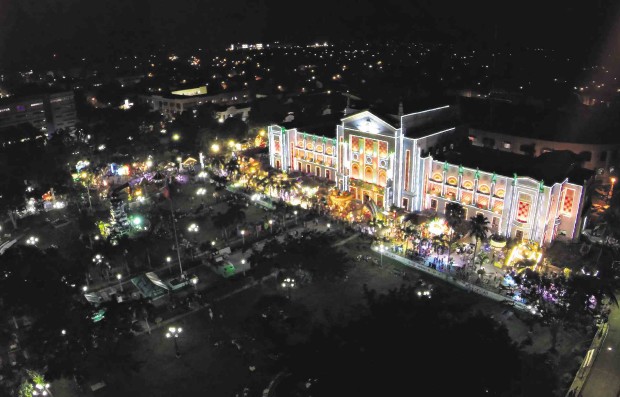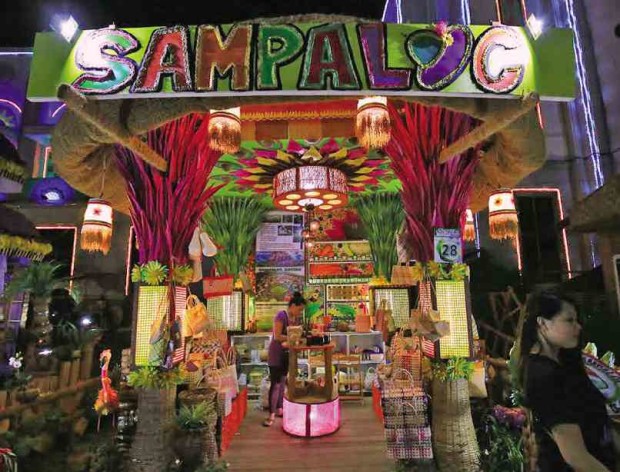A festival of Quezon culture, unity

AGLOW The Quezon provincial capitol building (above), aglow in multicolored lights, serves as a backdrop for this year’s Niyogyugan Festival, where the province’s coconut industry takes center stage. DELFIN P. MALLARI III
The success of the yearly Niyogyugan Festival in Quezon province no longer surprises its creator.
“When I conceptualized the province-wide coconut festival five years ago, I believed in its great potentials not only as a tourist attraction but also as an event that could unify Quezonians,” said former Quezon Rep. Aleta Suarez.
She was proven right. The “niyogyugan” event in one of the major coconut-producing provinces in the country has become a major crowd-drawer that attracts not only local but international tourists as well.
Alberto Bay Jr., provincial tourism officer, said that since Aug. 18, when the official count of visitors started, up to Aug. 22, the figure had reached 196,000. It could have been higher if not for the heavy rains during the past few days.
This year, the festival will last for 12 days—from Aug. 15 to 27. On the final day, spectators are expected to line along Lucena City’s streets to watch the street dancing parade and float competition.
For the first time, Lucena, the provincial capital, joined the festival, demonstrating that the provincial fiesta could unify officials and residents, regardless of political affiliations, as envisioned by its creator.
“It’s an honor for the local government and the people of Lucena to showcase the rich cultural tradition of the city during the festival,” Mayor Roderick Alcala said.
37 towns, 2 cities
From the initial 20 towns that joined the maiden festival in 2012, this year’s participants represented 37 towns and two cities. “This only shows the inherent unity of Quezonians when it comes to the promotion of the province as we all give a fitting tribute to the coconut as our main industry,” former Congresswoman Suarez said.
Social networking and video sharing sites have helped provide a wider audience.
The festival started from a weeklong Agri-Tourism Trade Exposition, which showcased the principal products of every town featured in colorful booths set up at the provincial capitol compound.
Its name is coined from the word “niyog” (Filipino for coconut) and “yugyog” (move to a fast beat). Aside from its original trade fair concept, it has been the local government’s way of recognizing the role of the coconut industry in the cultural and historical development of Quezon.
“The festival has become bigger, more colorful and now has also gained national recognition. This is all because of the result of the richness of our culture, talent and the potentials of Quezonians to be great,” said Gov. David Suarez, the former lawmaker’s son.

THE BOOTH of Sampaloc town features native bags, delicacies, decors and crafts. DELFIN T. MALLARI JR.
Unique character
The booths, all made from parts of the coconut tree, depict the unique character of the towns and their people. For one, the Infanta booth used layered coconut shells to depict the daily activities of coconut farmers. The roof of the Lopez booth is shaped like an open book to signify the town’s stature as the education center in southern Quezon, hosting several colleges and branches of state universities.
The booth of General Nakar, a town at the foot of the Sierra Madre mountain ranges in northern Quezon, represents its rich natural resources. Its green roof, made from dried coconut sheath, depicts a rainforest while the entrance arc is shaped like the Tulaog Cave, a sacred place for the indigenous Agta tribe.
Once night sets in, the façade of the three-story provincial capitol building transforms into a screen where multicolored lights, swaying to the beat of the festival theme song, are projected.
The festival coincides with the commemoration of the birth of former President Manuel L. Quezon and the awarding of the Quezon Medalya ng Karangalan (QMK) to the province’s outstanding citizens on Aug. 19.
The QMK awardees were Msgr. Leandro Castro (spiritual leadership), Nestor Pestelos (public service-community development), Josephine Argosino Jardin Fabre (culture and arts-music), Milada Dealo Valde (culture and arts-culinary), and Ricardo Merin Salumbides (farming).
On Tuesday, Governor Suarez led the awarding of outstanding farmers and fishermen during the “Araw ng Pamilyang Mag-sasaka” celebration held at Quezon Convention Center.
Among the festival visitors on Sunday were young professionals from Makati City, who treated themselves to local delicacies, such as “pancit habhab” (dried noodle dish from Lucban).
The booths around the capitol complex sell various products like “tinapa” (smoked fish) from Lucena City, the glutinous “suman” (rice cake) from Infanta and “longganisa” (pork sau-sage) from Lucban town, and native bags and hats from Sampaloc town.
“We’ve traveled for almost three hours just to see and have a feel of this unique festival. With these delicious food, we’re all having a blast,” said Joey Melendrez, a bank employee.